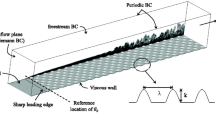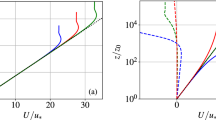Abstract
Modification of a turbulent flow upstream of a change in surface roughness has been studied by means of a stream function-vorticity model.
A flow reduction is found upstream of a step change in surface roughness when a fluid flows from a smooth onto a rough surface. Above that layer and above the region of flow reduction downstream of a smooth-rough transition, a flow acceleration is observed. Similar flow modification can be seen at a rough-smooth transition with the exception that flow reduction and flow acceleration are reversed. Within a fetch of −500 < x/z 0< + 500 (z 0 is the maximum roughness length, the roughness transition is located at x/z 0 = 0), flow reduction (flow acceleration) upstream of a roughness transition is one order of magnitude smaller than the flow reduction (flow acceleration) downstream of a smooth-rough (rough-smooth) transition. The flow acceleration (flow reduction) above that layer is two orders of magnitude.
The internal boundary layer (IBL) for horizontal mean velocity extends to roughly 300z 0 upstream of a roughness transition, whereas the IBL for turbulent shear stress as well as the distortion of flow equilibrium extend almost twice as far. For the friction velocity, an undershooting (overshooting) with respect to upstream equilibrium is predicted which precedes overshooting (undershooting) over new equilibrium just behind a roughness transition.
The flow modification over a finite fetch of modified roughness is weaker than over a corresponding fetch downstream of a single step change in roughness and the flow stays closer to upstream equilibrium. Even in front of the first roughness change of a finite fetch of modified roughness, a distortion of flow equilibrium due to the second, downwind roughness change can be observed.
Similar content being viewed by others
References
Anderson, D. A., Tannehill, J. C., and Pletcher, R. H.: 1984, Computational Fluid Mechanics and Heat Transfer, McGraw-Hill Book Co., New York, 599 pp.
Batchelor, G. K.: 1967, An Introduction to Fluid Dynamics, Cambridge University Press, Cambridge, 615 pp.
Bradley, E. F.: 1968, ‘A Micrometeorological Study of Velocity Profiles and Surface Drag in the Region Modified by a Change in Surface Roughness’, Quart. J. Roy. Meteorol. Soc. 94, 361–379.
Elliott, W. P.: 1958, ‘The Growth of the Atmospheric Internal Boundary’, Trans. Am. Geophys. Un. 39, 1048–1054.
Hinze, H. O.: 1975, Turbulence, McGraw-Hill Book Co., New York, 790 pp.
Lo, A. K.-F.: 1986, ‘On the Boundary-Layer Flow over a Canadian Archipelago Polynia’, Boundary-Layer Meteorol. 35, 53–71.
Lumley, J. L. and Panofsky, H. A.: 1964, The Structure of Atmospheric Turbulence, Interscience Publ., New York, 239 pp.
Orlanski, I.: 1976, ‘A Simple Boundary Condition for Unbounded Hyperbolic Flows’, J. Comp. Physics 21, 251–269.
Panofsky, H. A., Tennekes, H., Lenschow, D. H., and Wyngaard, J. C.: 1977, ‘The Characteristics of Turbulent Velocity Components in the Surface Layer Under Convective Conditions’, Boundary-Layer Meteorol. 11, 355–361.
Peterson, E. W.: 1969, ‘Modification of Mean Flow and Turbulent Energy by a Change in Surface Roughness Under Condition of Neutral Stability’, Quart. J. Roy. Meteorol. Soc. 95, 561–575.
Peterson, E. W.: 1972, ‘Relative Importance of Terms in the Turbulent Energy and Momentum Equations as Applied to the Problem of a Surface Roughness Change’, J. Atmos. Sci. 29, 1470–1476.
Peterson, E. W., Jensen, N. O., and Hojstrup, J.: 1979, ‘Observations of Downwind Development of Wind Speed and Variance Profiles at Bogenaes and Comparison with Theory’, Quart. J. R. Meteorol. Soc. 105, 521–529.
Rao, K. S., Wyngaard, J. C., and Coté, O. R.: 1974a, ‘The Structure of the Internal Boundary Layer over a Sudden Change of Surface Roughness’, J. Atmos. Sci. 31, 738–746.
Shir, C. C.: 1972, ‘A Numerical Computation of Air Flow Over a Sudden Change of Surface Roughness’, J. Atmos. Sci. 29, 304–310.
Taylor, P. A.: 1070, ‘A Model of Airflow Above Changes in Surface Heat Flux, Temperature and Roughness, for Neutral and Unstable Conditions’, Boundary-Layer Meteorol. 1, 18–39.
Townsend, A. A.: 1965, ‘The Response of a Turbulent Boundary Layer to Abrupt Changes in Surface Conditions’, J. Fluid Mech. 22, 799–822.
Author information
Authors and Affiliations
Rights and permissions
About this article
Cite this article
Claussen, M. The flow in a turbulent boundary layer upstream of a change in surface roughness. Boundary-Layer Meteorol 40, 31–86 (1987). https://doi.org/10.1007/BF00140068
Received:
Issue Date:
DOI: https://doi.org/10.1007/BF00140068




